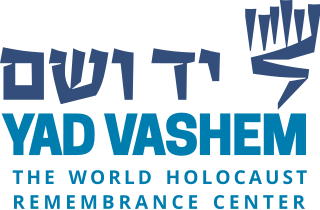
Yad Vashem is Israel's official memorial to the victims of the Holocaust. It is dedicated to preserving the memory of the Jews who were murdered; echoing the stories of the survivors; honoring Jews who fought against their Nazi oppressors and gentiles who selflessly aided Jews in need; and researching the phenomenon of the Holocaust in particular and genocide in general, with the aim of avoiding such events in the future. Yad Vashem's vision, as stated on its website, is: "To lead the documentation, research, education and commemoration of the Holocaust, and to convey the chronicles of this singular Jewish and human event to every person in Israel, to the Jewish people, and to every significant and relevant audience worldwide."
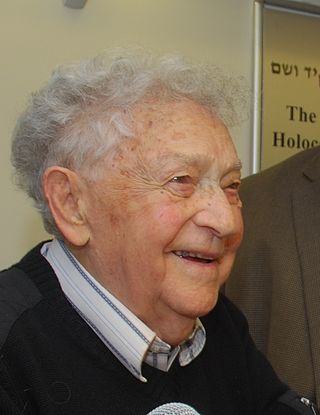
Yitzhak Arad was an Israeli historian, author, IDF brigadier general and Soviet partisan. He also served as Yad Vashem's director from 1972 to 1993, and specialised in the history of the Holocaust.
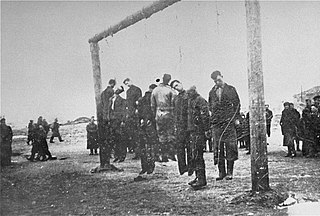
The Lwów Ghetto was a Nazi ghetto in the city of Lwów in the territory of Nazi-administered General Government in German-occupied Poland.
The history of the Jews during World War II is almost synonymous with the persecution and murder of Jews which was committed on an unprecedented scale in Europe and European North Africa. The massive scale of the Holocaust which happened during World War II greatly affected the Jewish people and world public opinion, which only understood the dimensions of the Final Solution after the war. The genocide, known as HaShoah in Hebrew, aimed at the elimination of the Jewish people on the European continent. It was a broadly organized operation led by Nazi Germany, in which approximately six million Jews were murdered methodically and with horrifying cruelty. Although the Holocaust was organized by the highest levels of the Nazi German government, the vast majority of Jews murdered were not German, but were instead residents of countries invaded by the Nazis after 1938. Of the approximately 6 million Jews murdered by the Nazis, approximately 160,000 to 180,000 were German Jews. During the Holocaust in occupied Poland, more than one million Jews were murdered in gas chambers of the Auschwitz concentration camp alone. The murder of the Jews of Europe affected Jewish communities in Albania, Austria, Belarus, Belgium, Bosnia & Herzegovina, Channel Islands, Croatia, Czech Republic, Estonia, France, Germany, Greece, Hungary, Italy, Latvia, Libya, Lithuania, Luxembourg, Moldova, the Netherlands, North Macedonia, Norway, Poland, Romania, Russia, Serbia, Slovakia, and Ukraine.
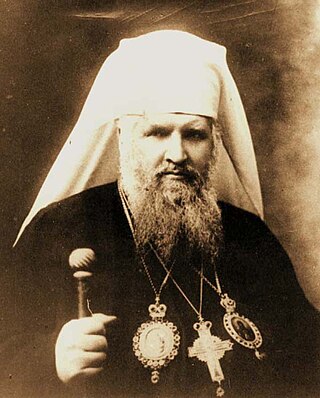
Andrey Sheptytsky, OSBM was the Greek Catholic Archbishop of Lviv and Metropolitan of Halych from 1901 until his death in 1944. His tenure in office spanned two world wars and seven political regimes: Austrian, Russian, Ukrainian, Polish, Soviet, Nazi German, and again Soviet.

Peremyshliany is a small city in Lviv Raion, Lviv Oblast (region) of Ukraine. It hosts the administration of Peremyshliany urban hromada, one of the hromadas of Ukraine. Population: 6,415.

Abraham Ozjasz Thon was a rabbi, early Zionist, and leader of the Jewish community in Poland.

The District of Galicia was a World War II administrative unit of the General Government created by Nazi Germany on 1 August 1941 after the start of Operation Barbarossa, based loosely within the borders of the ancient Principality of Galicia and the more recent Kingdom of Galicia and Lodomeria. Initially, during the invasion of Poland by Germany and the Soviet Union, the territory temporarily fell under Soviet occupation in 1939 as part of Soviet Ukraine.

Tempel Synagogue was a synagogue at the Old Market Square 14 in Lviv, now Ukraine. Lviv was one of the first Galician cities to have a modernized synagogue. The Synagogue was destroyed by Nazi Germany in 1941, following Operation Barbarossa.
The Tempel Synagogue was a Jewish synagogue in Przemyśl, Poland.
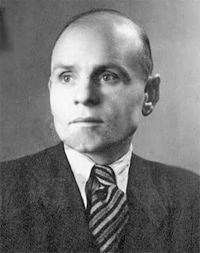
Leopold "Poldek" Socha was a Polish sewage inspector in the city of Lwów. During World War II, Socha used his knowledge of the city's sewage system to shelter a group of Jews from Nazi persecution and their supporters of different nationalities. In 1978 he was recognized by the State of Israel as Righteous Among the Nations.
The history of the Jews in Łęczna, Poland is first recorded and dated to 1501. The Jewish community of the town was evident and stable until the holocaust, after which it ceased to exist. The Glincman family from Wlodawa sent some family members to live there in the late 1800s to widen their business to surrounding towns. Nowadays monuments and buildings are still visible and commemorated in town.
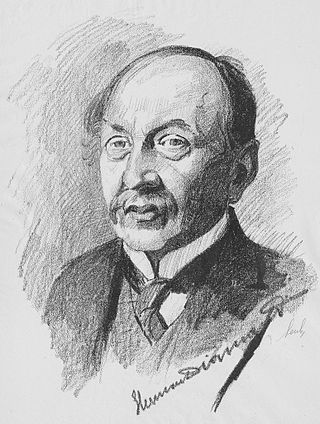
Herman Diamand was a Polish lawyer and socialist politician of Jewish origin, cofounder of Workers' Party of Galicia. Member of the Austrian parliament then member of the Polish Parlement till his death.
The following is a timeline of the history of the city of Lviv, Ukraine.

Aleksander Wacław Ładoś [alɛ'ksandɛr 'wadoɕ] was a Polish politician and diplomat, who 1940–45 headed the Legation of Poland to Switzerland. Ładoś was a member and de facto leader of the Ładoś Group, also known as Bernese Group, a secret action by the Polish diplomats and Jewish organizations who helped save several hundred Jews from the Holocaust by providing them with illegal Latin American, mostly Paraguayan passports.
Joseph S. Kutrzeba was a Polish-American theater producer and director.
Joseph Wilf was a Polish-American businessman, Holocaust survivor, and the co-founder of Garden Homes, one of the largest real estate development companies in the United States.
Shmuel Krakowski, Samuel Krakowski or Stefan Krakowski was an Israeli historian specializing in the Holocaust in Poland. After surviving the Holocaust, Krakowski worked for the intelligence and security services of the People's Republic of Poland. Later he became a Director of the Yad Vashem Archives in Israel.

Tadeusz Jerzy Gebethner was a Polish soldier, insurgent, bookseller, and footballer. From 1914 to 1925 he was an active player and captain of the Polonia Warsaw team; later he worked in his family bookstore and publishing business. Tadeusz Gebethner fought in the Polish–Soviet War and Polish September Campaign. Becoming an officer of the Home Army after the invasion, from 1942 he sheltered a Jewish family in his home in Warsaw during the German occupation. A participant of the Warsaw Uprising, he was critically wounded and taken prisoner to Stalag-XIA, where he died from the same injuries on 14 October 1944. For his wartime activities, he was recognised as one of the Polish Righteous Among the Nations in 1981.












